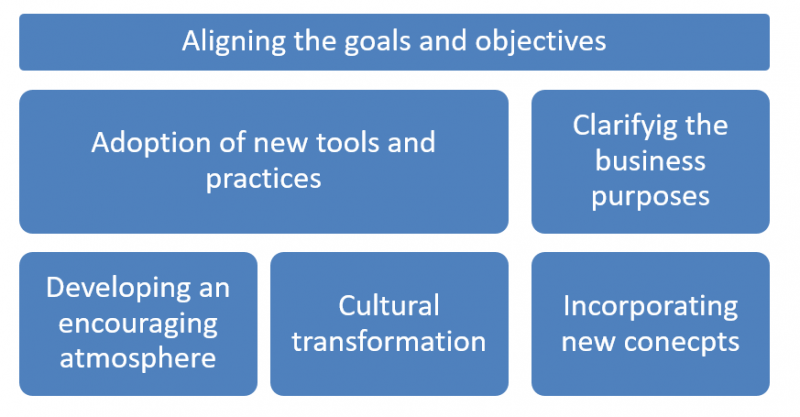The only way to survive in the world of business is by evolving according to the market forces and the latest technologies. The transformation to the agile environment is one such process being undertaken by the corporate world in the 21st century. The transformation towards agile methodology provides flexible work method, time efficiency, accuracy and better results. However, moving from the waterfall approach towards the agile framework brings with itself a lot of transitional changes and one such important change is the cultural transition that the developing teams have to undergo for incorporating the scrum technology in the pre-existing environment. To know more about Scrum Master Certification please visit StarAgile site.
The struggle of transition
There are many battles that a team has to win in order to get the victory in the ultimate battle of transitioning to the agile framework. The following table lists the few struggles that one has to undergo-

The clarity of vision and objective is the most important aspect while transiting from the waterfall concept to an agile framework. Once the whole team is clear on this, it becomes easy for the team member to draw his/her path to make the transition happen; similarly the stakeholders must take care of developing an encouraging atmosphere for the members so that it becomes easy to grasp the new concepts. The mentoring and guidance at each step is the supreme tool for an easy and effective transition. An expert can help the smooth transformation by incorporating his experience and by acting as a guiding torch for the people under work.
Cultural urges to improve the probability of success while transitioning
- Have an urge to change- A strong urge to change is a most desirable push if one wants to move from a traditional approach to scrum methodology. The way in which people take their jobs tells a lot about the end product. So the excitement and enthusiasm are must for effective transitioning.
- Proper mentoring- A will to change clubbed with an expert hand can do wonders. Each team member must be guided properly and should be fully aware of the transitioning process. Without the expert, the transition can lead you into the pit of failure rather than climbing the hill of success.
- Inspiration- Inspiration and motivation are the two pillars on which depends on the grand success of the plan. The agile framework does not works on top-down hierarchy, as it is more of the horizontal approach so each member must be self driven and self motivating.
- Communication is the key- When a framework is set up on the horizontal approach rather than the vertical one then there is no leader, each team member works individually. Hence the communication part must be highly developed amongst each member of the team so that they can work on the same level and on the same page. Hence communication marks a great parameter for the end product.
- The learning curve- The transition is always slow. So one must not try to be impatient while culturally transitioning. Each teammate has to learn tonnes of new things. Hence a subtle and timely learning curve must be allowed in order to let them grasp the new ideas and transform them into the finished products.
Types of cultures
In the traditional approach, there used to be four types of cultures that were existing in a business model. These were power culture, role culture, task culture and person culture. The power culture involves the environment in which the power is concentrated in a few hands and they are surrounded by a few powerful people taking the necessary actions. Here the involvement of the whole team never took place. In role culture, the basic bureaucrat fashion is followed in which all the communication process is followed from top to down and horizontal, in task culture, all the focus is on completing the task on time and the communication is done only within the cluster involved in completing that given task and in person culture all the members of the whole business arena come together for exchanging skills and other recreational activities.
In scrum framework all of these cultures don’t exist. Only task and person culture are of some importance, two other cultures are almost obsolete in this respect. However, a few elements of all the cultures are incorporated but the above two mentioned are of more prominence. So the transition is not to the entire new concept, it does have some overlapping with the pre-existing framework.
Steps involved in cultural transitioning of the team
Broadly mentioning, there are three steps which need to be considered to lead towards the better cultural transitioning. These are the mechanics of Agile, the positive mindset and the technical skill.
- The first step is to understand the hidden mechanics of Agile framework which involves understanding the concept of end product formation, horizontal approach, individual working, effective communication, sprint meetings, product backlogs and ever evolving priorities.
- The second step which forms the foundation of any work is the right mindset. In an agile framework as discussed earlier all the team members work individually. So having a career driven approach with a pinch of imagination can help the work to be done qualitatively. The individual is responsible to be ever evolving and being able to have right amount of communication with all the team members.
- The last step is the one about technical skill. Only a skilful hand can bring the idea to life. Deep knowledge of the subject and practical implementation can bring out the end product which is most useful.
The cultural transitioning is not an entirely isolated process, it has many overlapping features with the traditional approach. However, the cultural transition forms a backbone for any framework to be incorporated. So to have a proliferating business, a culturally evolved environment can give ma more smooth base for the effective agile transformation to take place.












Add Comment